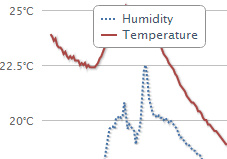Remote monitoring with Arduino (part 4)
February 2013 (237 Words, 2 Minutes)
This is the final part in the series of articles (parts 1, 2, 3) about building a remote home monitoring system based on Arduino.
Lessons learned

The monitoring task I’ve had was unusual enough to justify building my own system. For more typical tasks, like monitoring the inside/outside temperature, it would be much easier to buy a relatively inexpensive thermometer with a PC interface. Overall cost of the built system is in the ballpark of some $150-170 – still way below what the commercial systems cost (especially with multiple sensors and flood detection) When it comes to the power consumption, commercial consumer electronics sensors are way more efficient. A typical temperature sensor can run on a couple of batteries for many months, whereas an Arduino-based device would have to draw AC power. Wireless communications are painful 🙂 I am yet to look into the message corruption issues described in the previous article.
Future directions
Presentation might need some improvement. Currently Highcharts determines the Y scale dynamically, making relatively small temperature fluctuations look too dramatic. Forcing the scale might make it more meaningful. An alarm mechanism is needed to alert me on water level change. It would be great to find a way to read the wireless data emitted by one of the cheap commercial temperature sensors. That way, one could potentially stick a lot of sensors around the place (assuming those come with some notion of a unique ID), have them run on batteries and read them all using a single Arduino device. I will definitely look into this more. There is a lot of wireless motion open/close sensors on the market operating using different smarthome protocols (X10, ZigBee, etc). Having a way to read and decode their wireless messages would allow extending the monitoring functionality by sending an alarm if one of such sensors is triggered. When it comes to X10, there are two options:
- Use a USB dongle CM19A that speaks X10. Although it is not 100% certain, this device is apparently capable of receiving messages from X10 wireless sensors.
- Again, using Arduino with a 433MHz wireless receiver – apparently there is an effort underway to make Arduino parse those messages.
Finally, it would be nice to add more active temperature control for the house but currently it has independent heaters in each room, so it would require somewhat more work in order to switch them to a unified temperature control.